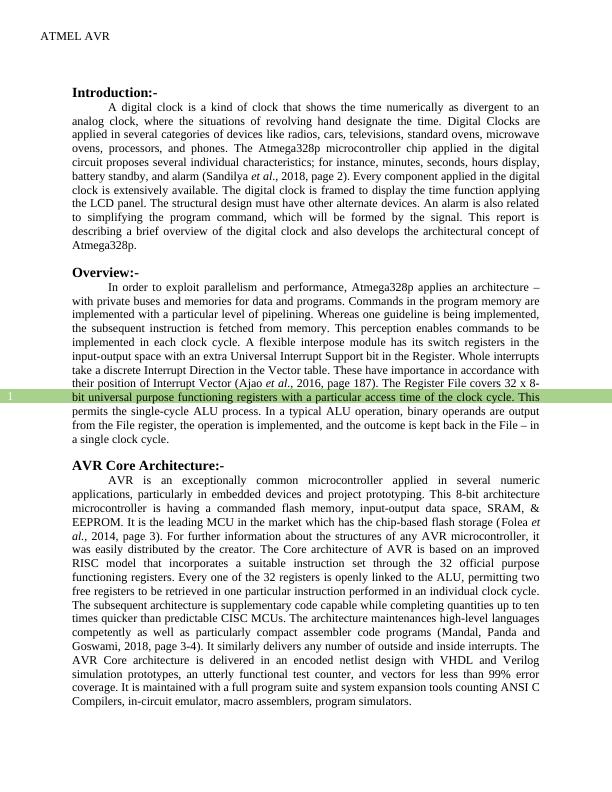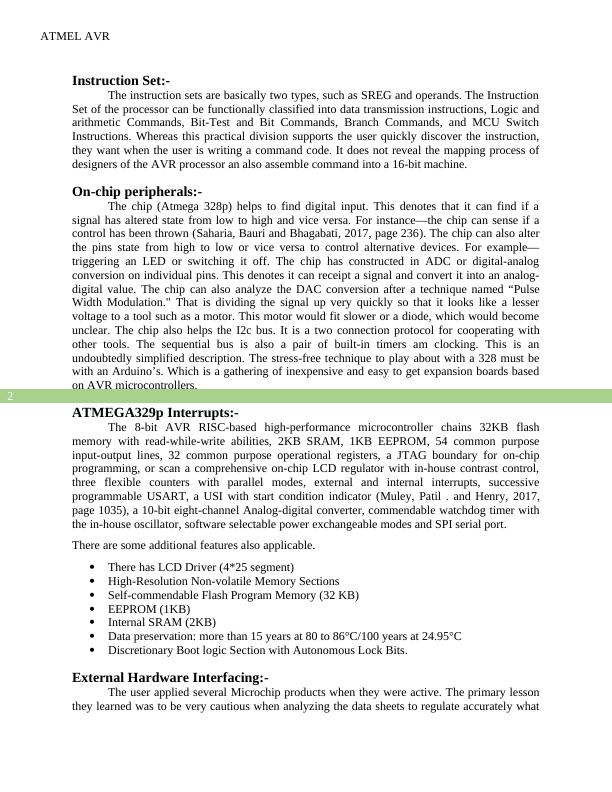Digital Clocks are applied in several categories
Write a written report on Atmel AVR Architecture for the Computer Architecture module.
7 Pages3073 Words19 Views
Added on 2022-09-06
About This Document
Assignment attached below, we have not been told how many words the report is meant to be.
Digital Clocks are applied in several categories
Write a written report on Atmel AVR Architecture for the Computer Architecture module.
Added on 2022-09-06
ShareRelated Documents
Running head: ATMEL AVR
ATMEL AVR
Name of the Student:
Name of the university:
Author’s note:
ATMEL AVR
Name of the Student:
Name of the university:
Author’s note:

ATMEL AVR
1
Introduction:-
A digital clock is a kind of clock that shows the time numerically as divergent to an
analog clock, where the situations of revolving hand designate the time. Digital Clocks are
applied in several categories of devices like radios, cars, televisions, standard ovens, microwave
ovens, processors, and phones. The Atmega328p microcontroller chip applied in the digital
circuit proposes several individual characteristics; for instance, minutes, seconds, hours display,
battery standby, and alarm (Sandilya et al., 2018, page 2). Every component applied in the digital
clock is extensively available. The digital clock is framed to display the time function applying
the LCD panel. The structural design must have other alternate devices. An alarm is also related
to simplifying the program command, which will be formed by the signal. This report is
describing a brief overview of the digital clock and also develops the architectural concept of
Atmega328p.
Overview:-
In order to exploit parallelism and performance, Atmega328p applies an architecture –
with private buses and memories for data and programs. Commands in the program memory are
implemented with a particular level of pipelining. Whereas one guideline is being implemented,
the subsequent instruction is fetched from memory. This perception enables commands to be
implemented in each clock cycle. A flexible interpose module has its switch registers in the
input-output space with an extra Universal Interrupt Support bit in the Register. Whole interrupts
take a discrete Interrupt Direction in the Vector table. These have importance in accordance with
their position of Interrupt Vector (Ajao et al., 2016, page 187). The Register File covers 32 x 8-
bit universal purpose functioning registers with a particular access time of the clock cycle. This
permits the single-cycle ALU process. In a typical ALU operation, binary operands are output
from the File register, the operation is implemented, and the outcome is kept back in the File – in
a single clock cycle.
AVR Core Architecture:-
AVR is an exceptionally common microcontroller applied in several numeric
applications, particularly in embedded devices and project prototyping. This 8-bit architecture
microcontroller is having a commanded flash memory, input-output data space, SRAM, &
EEPROM. It is the leading MCU in the market which has the chip-based flash storage (Folea et
al., 2014, page 3). For further information about the structures of any AVR microcontroller, it
was easily distributed by the creator. The Core architecture of AVR is based on an improved
RISC model that incorporates a suitable instruction set through the 32 official purpose
functioning registers. Every one of the 32 registers is openly linked to the ALU, permitting two
free registers to be retrieved in one particular instruction performed in an individual clock cycle.
The subsequent architecture is supplementary code capable while completing quantities up to ten
times quicker than predictable CISC MCUs. The architecture maintenances high-level languages
competently as well as particularly compact assembler code programs (Mandal, Panda and
Goswami, 2018, page 3-4). It similarly delivers any number of outside and inside interrupts. The
AVR Core architecture is delivered in an encoded netlist design with VHDL and Verilog
simulation prototypes, an utterly functional test counter, and vectors for less than 99% error
coverage. It is maintained with a full program suite and system expansion tools counting ANSI C
Compilers, in-circuit emulator, macro assemblers, program simulators.
1
Introduction:-
A digital clock is a kind of clock that shows the time numerically as divergent to an
analog clock, where the situations of revolving hand designate the time. Digital Clocks are
applied in several categories of devices like radios, cars, televisions, standard ovens, microwave
ovens, processors, and phones. The Atmega328p microcontroller chip applied in the digital
circuit proposes several individual characteristics; for instance, minutes, seconds, hours display,
battery standby, and alarm (Sandilya et al., 2018, page 2). Every component applied in the digital
clock is extensively available. The digital clock is framed to display the time function applying
the LCD panel. The structural design must have other alternate devices. An alarm is also related
to simplifying the program command, which will be formed by the signal. This report is
describing a brief overview of the digital clock and also develops the architectural concept of
Atmega328p.
Overview:-
In order to exploit parallelism and performance, Atmega328p applies an architecture –
with private buses and memories for data and programs. Commands in the program memory are
implemented with a particular level of pipelining. Whereas one guideline is being implemented,
the subsequent instruction is fetched from memory. This perception enables commands to be
implemented in each clock cycle. A flexible interpose module has its switch registers in the
input-output space with an extra Universal Interrupt Support bit in the Register. Whole interrupts
take a discrete Interrupt Direction in the Vector table. These have importance in accordance with
their position of Interrupt Vector (Ajao et al., 2016, page 187). The Register File covers 32 x 8-
bit universal purpose functioning registers with a particular access time of the clock cycle. This
permits the single-cycle ALU process. In a typical ALU operation, binary operands are output
from the File register, the operation is implemented, and the outcome is kept back in the File – in
a single clock cycle.
AVR Core Architecture:-
AVR is an exceptionally common microcontroller applied in several numeric
applications, particularly in embedded devices and project prototyping. This 8-bit architecture
microcontroller is having a commanded flash memory, input-output data space, SRAM, &
EEPROM. It is the leading MCU in the market which has the chip-based flash storage (Folea et
al., 2014, page 3). For further information about the structures of any AVR microcontroller, it
was easily distributed by the creator. The Core architecture of AVR is based on an improved
RISC model that incorporates a suitable instruction set through the 32 official purpose
functioning registers. Every one of the 32 registers is openly linked to the ALU, permitting two
free registers to be retrieved in one particular instruction performed in an individual clock cycle.
The subsequent architecture is supplementary code capable while completing quantities up to ten
times quicker than predictable CISC MCUs. The architecture maintenances high-level languages
competently as well as particularly compact assembler code programs (Mandal, Panda and
Goswami, 2018, page 3-4). It similarly delivers any number of outside and inside interrupts. The
AVR Core architecture is delivered in an encoded netlist design with VHDL and Verilog
simulation prototypes, an utterly functional test counter, and vectors for less than 99% error
coverage. It is maintained with a full program suite and system expansion tools counting ANSI C
Compilers, in-circuit emulator, macro assemblers, program simulators.

ATMEL AVR
2
Instruction Set:-
The instruction sets are basically two types, such as SREG and operands. The Instruction
Set of the processor can be functionally classified into data transmission instructions, Logic and
arithmetic Commands, Bit-Test and Bit Commands, Branch Commands, and MCU Switch
Instructions. Whereas this practical division supports the user quickly discover the instruction,
they want when the user is writing a command code. It does not reveal the mapping process of
designers of the AVR processor an also assemble command into a 16-bit machine.
On-chip peripherals:-
The chip (Atmega 328p) helps to find digital input. This denotes that it can find if a
signal has altered state from low to high and vice versa. For instance—the chip can sense if a
control has been thrown (Saharia, Bauri and Bhagabati, 2017, page 236). The chip can also alter
the pins state from high to low or vice versa to control alternative devices. For example—
triggering an LED or switching it off. The chip has constructed in ADC or digital-analog
conversion on individual pins. This denotes it can receipt a signal and convert it into an analog-
digital value. The chip can also analyze the DAC conversion after a technique named “Pulse
Width Modulation." That is dividing the signal up very quickly so that it looks like a lesser
voltage to a tool such as a motor. This motor would fit slower or a diode, which would become
unclear. The chip also helps the I2c bus. It is a two connection protocol for cooperating with
other tools. The sequential bus is also a pair of built-in timers am clocking. This is an
undoubtedly simplified description. The stress-free technique to play about with a 328 must be
with an Arduino’s. Which is a gathering of inexpensive and easy to get expansion boards based
on AVR microcontrollers.
ATMEGA329p Interrupts:-
The 8-bit AVR RISC-based high-performance microcontroller chains 32KB flash
memory with read-while-write abilities, 2KB SRAM, 1KB EEPROM, 54 common purpose
input-output lines, 32 common purpose operational registers, a JTAG boundary for on-chip
programming, or scan a comprehensive on-chip LCD regulator with in-house contrast control,
three flexible counters with parallel modes, external and internal interrupts, successive
programmable USART, a USI with start condition indicator (Muley, Patil . and Henry, 2017,
page 1035), a 10-bit eight-channel Analog-digital converter, commendable watchdog timer with
the in-house oscillator, software selectable power exchangeable modes and SPI serial port.
There are some additional features also applicable.
There has LCD Driver (4*25 segment)
High-Resolution Non-volatile Memory Sections
Self-commendable Flash Program Memory (32 KB)
EEPROM (1KB)
Internal SRAM (2KB)
Data preservation: more than 15 years at 80 to 86°C/100 years at 24.95°C
Discretionary Boot logic Section with Autonomous Lock Bits.
External Hardware Interfacing:-
The user applied several Microchip products when they were active. The primary lesson
they learned was to be very cautious when analyzing the data sheets to regulate accurately what
2
Instruction Set:-
The instruction sets are basically two types, such as SREG and operands. The Instruction
Set of the processor can be functionally classified into data transmission instructions, Logic and
arithmetic Commands, Bit-Test and Bit Commands, Branch Commands, and MCU Switch
Instructions. Whereas this practical division supports the user quickly discover the instruction,
they want when the user is writing a command code. It does not reveal the mapping process of
designers of the AVR processor an also assemble command into a 16-bit machine.
On-chip peripherals:-
The chip (Atmega 328p) helps to find digital input. This denotes that it can find if a
signal has altered state from low to high and vice versa. For instance—the chip can sense if a
control has been thrown (Saharia, Bauri and Bhagabati, 2017, page 236). The chip can also alter
the pins state from high to low or vice versa to control alternative devices. For example—
triggering an LED or switching it off. The chip has constructed in ADC or digital-analog
conversion on individual pins. This denotes it can receipt a signal and convert it into an analog-
digital value. The chip can also analyze the DAC conversion after a technique named “Pulse
Width Modulation." That is dividing the signal up very quickly so that it looks like a lesser
voltage to a tool such as a motor. This motor would fit slower or a diode, which would become
unclear. The chip also helps the I2c bus. It is a two connection protocol for cooperating with
other tools. The sequential bus is also a pair of built-in timers am clocking. This is an
undoubtedly simplified description. The stress-free technique to play about with a 328 must be
with an Arduino’s. Which is a gathering of inexpensive and easy to get expansion boards based
on AVR microcontrollers.
ATMEGA329p Interrupts:-
The 8-bit AVR RISC-based high-performance microcontroller chains 32KB flash
memory with read-while-write abilities, 2KB SRAM, 1KB EEPROM, 54 common purpose
input-output lines, 32 common purpose operational registers, a JTAG boundary for on-chip
programming, or scan a comprehensive on-chip LCD regulator with in-house contrast control,
three flexible counters with parallel modes, external and internal interrupts, successive
programmable USART, a USI with start condition indicator (Muley, Patil . and Henry, 2017,
page 1035), a 10-bit eight-channel Analog-digital converter, commendable watchdog timer with
the in-house oscillator, software selectable power exchangeable modes and SPI serial port.
There are some additional features also applicable.
There has LCD Driver (4*25 segment)
High-Resolution Non-volatile Memory Sections
Self-commendable Flash Program Memory (32 KB)
EEPROM (1KB)
Internal SRAM (2KB)
Data preservation: more than 15 years at 80 to 86°C/100 years at 24.95°C
Discretionary Boot logic Section with Autonomous Lock Bits.
External Hardware Interfacing:-
The user applied several Microchip products when they were active. The primary lesson
they learned was to be very cautious when analyzing the data sheets to regulate accurately what

End of preview
Want to access all the pages? Upload your documents or become a member.
Related Documents
Digital Clock Application with ATMEGA328p Microprocessorlg...
|5
|1103
|428
Embedded System Design PDFlg...
|28
|5205
|21
